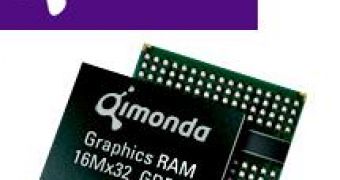Qimonda AG, the former Infineon, recently unveiled a GDDR-3 module with working clock of 1GHz DDR, equaling the clock of GDDR-4 memory. The GDDR-3 at 1GHz isn't the final clock engineers are hoping to achieve, with goals being set thoroughly at 1.2 GHz (2.4 GHz). When asked about GDDR4, an engineer told The inquirer that Qimonda isn't planning GDDR4, but rather switching to GDDR5 later in the year. The producer has collected half a billion US dollars on its IPO in August and is now shipping millions of memory chips for the Microsoft Xbox 360 console.
Although reporters asked for it, no further details were given up about GDDR5 specs. For manufacturing purposes of DDR2, DDR3 and GDDR3 memory, Qimonda will rely on joint-development of 75 nm manufacturing process with Nanya.
On September 18th, 2006 Qimonda AG and Nanya Technology Corporation announced the successful qualification of the 75nm DRAM Trench technology, and the first 75nm product offered to the market, a 512Mb DDR2 memory chip. This next generation technology platform has structure sizes going down to 70 nm. The technology and 512Mb DDR2 product have been jointly developed at Qimonda's Development Centers in Dresden and Munich, Germany. Volume production in the new DRAM technology generation has been started at Qimonda's 300mm production line in Dresden.
"With the qualification of our 75nm DRAM Trench technology and the first product we have reached an important milestone on our technology roadmap. The 75nm technology platform satisfies the performance requirements of upcoming high speed interfaces such as used for DDR3 and graphics products", said Thomas Seifert, Member of the Management Board, Market and Operations at Qimonda. At the same time, Dr. Pei Lin Pai, Vice President of Global Sales & Marketing and Spokesman of Nanya Technology Corporation, said that "the product features leading edge technologies with minimum geometries as small as 70nm. The advanced technologies enable us for high performance and high density, such as 1Gb / 2Gb DRAM, with competitive cost structure."

 14 DAY TRIAL //
14 DAY TRIAL //